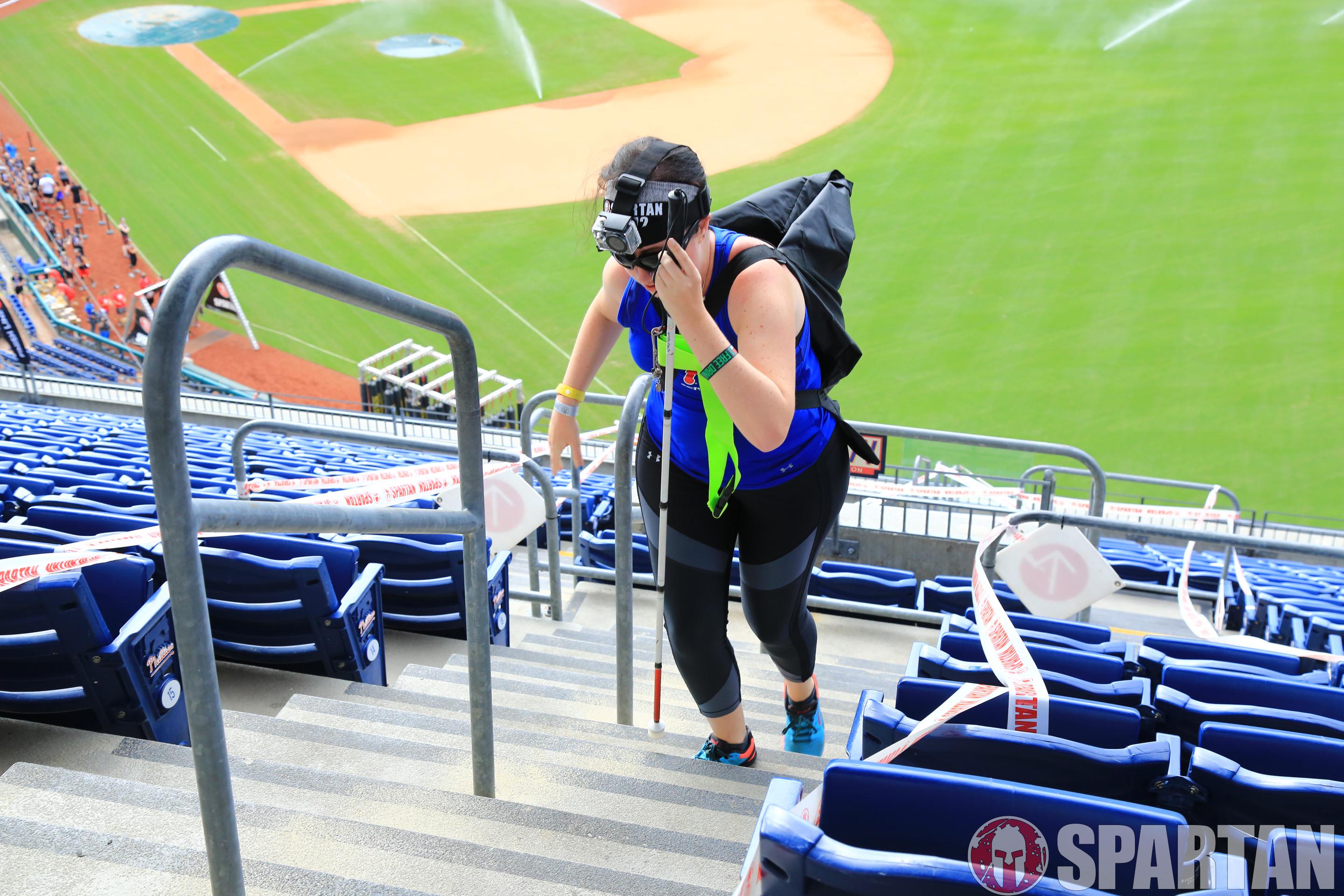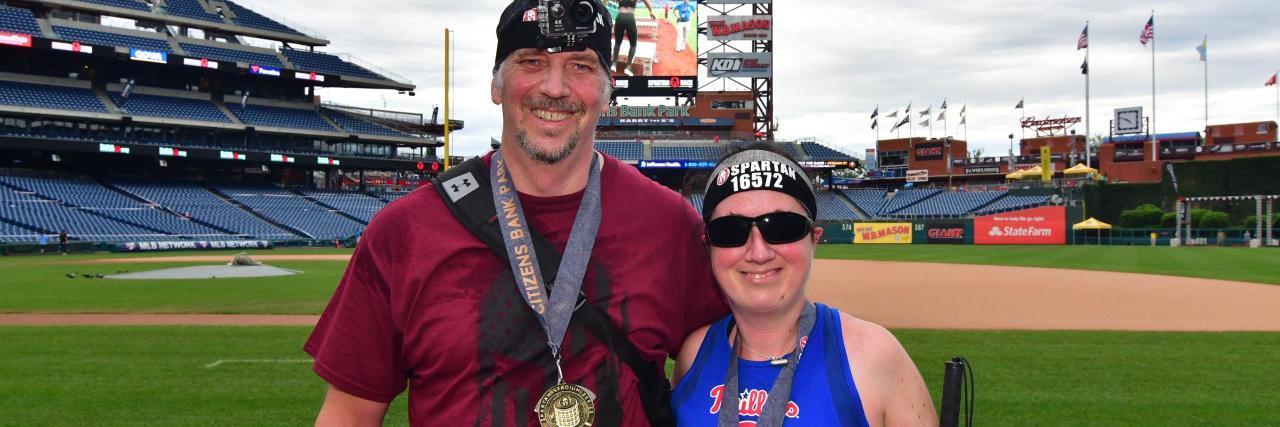For most the two words “blind” and “athlete” sound mutually exclusive. How could someone who can’t see catch a ball, navigate a field full of players or find a puck? And to be fair, it is highly unlikely we will ever see blind athletes playing for the NHL. As a kid I never thought it would be possible for me to call myself an athlete. I was acutely aware of how much my lack of vision was a roadblock to participating in sports with sighted kids in any meaningful way. Whether in gym class or at a friend’s house, I was always the token “blind kid” the other kids didn’t want on their teams.
Up until the last few decades, blind athletes had only a handful of options such as beep baseball leagues and for elite athletes, the Paralympics. Thanks to the rise in popularity of fitness based tournaments such as the CrossFit Games, Spartan Races, and Tough Mudders, athletes both sighted and blind now have the opportunity to compete together.
If you would have asked the younger version of me if I believed I’d ever be an athlete, I would have laughed. Fast forward to today and here I am, spending nine-plus hours a week in the gym training and racing various Spartan competitions with sighted athletes.
With more opportunities to compete with sighted athletes, there are some differences in experience for us that are not present when competing in a visually impaired environment. For sighted readers, I hope these five areas will give some insight in what you might notice — and how to respond — should you find yourself in an athletic environment with someone who is blind.
1. Sometimes blind athletes need modifications.
Despite athletic ability, some things need modifications. For example, in the last Spartan I ran, one of the obstacles involved athletes carrying a 35 pound sandbag up and down stadium steps. The obstacle itself is not particularly physically challenging for me, however to do it safely I need one hand for my white cane and one hand for the railings on the steps. This leaves me with no way to safely carry the sandbag. The modification for this is simple — a laundry bag with shoulder straps and a luggage strap holding the shoulder straps in place.
Small modifications like the one mentioned above make it possible for blind athletes to enjoy the same space as sighted athletes. Blind athletes start at a disadvantage, but with some creative thinking and determination we can even out the playing field.

2. Sighted guides help blind athletes navigate.
Sighted guides make obstacle races, marathons, and other races possible for blind athletes. They guide in a number of ways depending on the athlete’s preferences. Runners will often use a tether between themselves and their guide. I have enough vision to see my racing companion, so much prefer to use my cane and get verbal feedback from my guide about where to turn and anything in the path I need to know about before my cane reaches it, such as steps when I’m running.
There is an opportunity here for the general public to assume a strange power dynamic here — primarily that the guide is doing some community service by helping “that poor blind person.” I am deeply thankful for my guide and best friend, and the relationship between guide and racer is equal. We are a team, both working toward our own personal goals. Both the blind racer and sighted guide are athletes, both are racing and they work together as a highly efficient team.
3. Most competitions aren’t built for us, but that’s OK.
Just like the rest of life, competitions, races, games and gyms are generally not designed with blind athletes in mind. For example, most obstacles in the Spartan take vision for granted and doing them without it is very tough. I’m still searching for a modification that will allow me to get a running start on the walls we are supposed to scale without running face first into the wall! With that said,
this is about competing in the same space as the sighted world and being a part of the larger community. Unless we want to stay only the realm of blind leagues (and there is nothing wrong with that) we have to adapt, be flexible and think creatively.
4. Blind athletes want to compete fairly and honestly.
In open events where there is no prize at stake, some refs will suggest cheating or at least will allow you to bend the rules. I was in a race recently where a ref suggested that I didn’t have to do the penalty burpees when I missed the obstacle. As tempting as skipping burpees always is, this is about having integrity as an athlete. In the ref’s kind attempt to make things easier for a blind athlete, he wanted to skew the race in a way that was no longer a fair playing field for everyone else. I race to test my own physical skill, mental toughness, and I enjoy it. If I cheat, my results (time and placement) will be wrong and so will the results of those close to me in the race. I lose my ability
to track my progress and pride in achievement. On another level the “special treatment” indirectly communicates that I am not strong or skilled enough to complete the task at hand, which is unacceptable to me.
5. People often view blind athletes as inspirational.
When you compete as a blind athlete, many people will cheer you on and let you know how inspiring you are. I realize that this may be undesirable to many in the disabled community. We have heard how “inspirational” we are throughout our lives for doing ordinary tasks like meeting friends or grocery shopping. This is usually tied into power differentials in society, and most of us cringe when it’s said. However, being a disabled athlete is not ordinary.
Being a blind athlete at any level is incredibly difficult. The deck is stacked against us both in terms of our vision as well as societal views of what is possible. Five days a week I am in the gym training, and each of those days requires modifications, dedication and nerves of steel. If that can inspire someone to get off the couch and change their life, then I am all for it.
On a practical level, being an inspiration makes racing much easier as well. I used to worry about my speed on some of the obstacles. I didn’t want people behind me to get mad because I could only descend from the top of the stadium as fast as my cane would find the text step. When people see the cane though, their attitude changes and instead of an angry competitor, I have a new friend.
Training and competing is both addictive and one of the most fulfilling things I do. Pushing myself beyond what I and others believe is possible is exciting and keeps me moving forward. Stepping into the role of “athlete” allows me to step out of an identity of blindness that society has projected on me, and into a version of myself that challenges stereotypes and motivates others to push through their own limitations and realize they can achieve their dreams with hard work and relentless determination.

